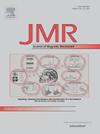强耦合自旋系统核磁共振波谱的神经网络分析
IF 2
3区 化学
Q3 BIOCHEMICAL RESEARCH METHODS
引用次数: 0
摘要
从质子 NMR 光谱中提取化学位移和耦合常数等参数通常是利用光谱进行化合物鉴定和结构确定的第一步。当质子间的标量耦合与化学位移差异(强耦合)大小相当时,这可能会变得具有挑战性,低场(台式)光谱仪通常就是这种情况。在此,我们探讨了人工智能方法(尤其是神经网络)在从低场光谱中提取参数方面的潜在用途。我们没有寻求大型实验光谱集来训练网络,而是选择了量子力学模拟光谱集,这在现代软件包和计算机资源条件下是可行的。我们的研究表明,在二维 J 分辨光谱上训练的网络可应用于依度酸的光谱,该网络的应用显示了一些前景,但也遇到了一些障碍。我们建议通过改进脉冲序列和更广泛的模拟来克服这些障碍。本文章由计算机程序翻译,如有差异,请以英文原文为准。

Neural net analysis of NMR spectra from strongly-coupled spin systems
Extracting parameters such as chemical shifts and coupling constants from proton NMR spectra is often a first step in using spectra for compound identification and structure determination. This can become challenging when scalar couplings between protons are comparable in size to chemical shift differences (strongly coupled), as is often the case with low-field (bench top) spectrometers. Here we explore the potential utility of AI methods, in particular neural networks, for extracting parameters from low-field spectra. Rather than seeking large experimental sets of spectra for training a network, we chose quantum mechanical simulation of sets, something that is possible with modern software packages and computer resources. We show that application of a network trained on 2-D J-resolved spectra and applied to a spectrum of iduronic acid, shows some promise, but also meets with some obstacles. We suggest that these may be overcome with improved pulse sequences and more extensive simulations.
求助全文
通过发布文献求助,成功后即可免费获取论文全文。
去求助
来源期刊
CiteScore
3.80
自引率
13.60%
发文量
150
审稿时长
69 days
期刊介绍:
The Journal of Magnetic Resonance presents original technical and scientific papers in all aspects of magnetic resonance, including nuclear magnetic resonance spectroscopy (NMR) of solids and liquids, electron spin/paramagnetic resonance (EPR), in vivo magnetic resonance imaging (MRI) and spectroscopy (MRS), nuclear quadrupole resonance (NQR) and magnetic resonance phenomena at nearly zero fields or in combination with optics. The Journal''s main aims include deepening the physical principles underlying all these spectroscopies, publishing significant theoretical and experimental results leading to spectral and spatial progress in these areas, and opening new MR-based applications in chemistry, biology and medicine. The Journal also seeks descriptions of novel apparatuses, new experimental protocols, and new procedures of data analysis and interpretation - including computational and quantum-mechanical methods - capable of advancing MR spectroscopy and imaging.

 求助内容:
求助内容: 应助结果提醒方式:
应助结果提醒方式:


